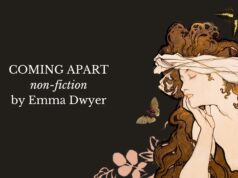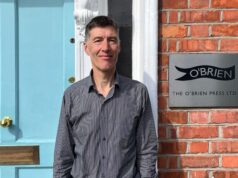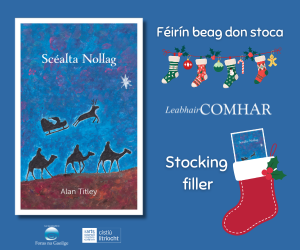
Bone House|Moyra Donaldson|Doire Press 2021|ISBN: 978-1-907682-81-0|€12
Aoife Lyall talks to Moyra Donaldson about her new collection, Bone House
Moyra Donaldson strikes hard truths with a light touch. The poems in Bone House resonate with candour, warmth and vitality. In the opening poem, ‘So What if We Break Them,’ are the watermarks of the collection: authority, ownership, reclamation.
Who would say you are writing for here, and who, or what, are you writing against?
This poem was written at the beginning of the first lockdown, when the pandemic became a reality in our lives. It was a time of fear and confusion, everything had changed, nothing felt the same and we were staring at our mortality face to face in a way that we are seldom forced to do.
I had this sense that all the things we keep for some time in the future, the ‘good’ things that we keep in our cupboards, rarely using them, needed to be brought out and made use of. What are we saving them for? The future is not guaranteed to any of us, the time to enjoy what we have is now. I was writing for myself, instructing myself to enjoy the things I have, to not be fearful of what might happen to them in some hypothetical time to come. This sense moved into the rest of the collection in terms of not being afraid to just say things, to not always be trying to make sense, or to ameliorate the past, to just let things out into the light.
I was writing against the fear of my own voice, of being judged. I was writing against silence, against dread, against my upbringing that demanded not saying. I was giving myself permission. Writing against the dark and the hidden.
‘Bone House’ being both a term for the human body and the building used to house the dead, Donaldson’s invocation of vivid and disturbing events from the past simultaneously brings them to life and puts them to rest. In ‘Drumhirk’, she recalls how “the rats poured out in a grey / flowering of horror. The dogs grabbed, shook, broke necks; / blood on their muzzles.” In ‘Blowfies, Love’, she embraces the languid swarm born of an unknown corpse:
Something must have died behind the kitchen cupboards
for each morning there’s another batch of blowfly;
slow and empty though, vacant, as if whatever hatched them
was not wet enough, not sufficiently putrescent
to nurture more than these zombie flies
Her reckoning of these events is unflinching, particularly in ‘One of My Mother’s Stories’ and ‘Another of Her Stories’, both poems recalling singular events which epitomise how quiet cruelties cast long shadows:
The mare that pulled the plough wouldn’t accept her foal,
kicked it in the head and killed it. Same the next year,
wouldn’t let the foal feed and it died. The third year my
grandfather put a sling round the mare’s belly, ropes around
the rafters, and hoisted her up so she couldn’t move, could
do nothing but let the foal suckle.
(‘One of Mother’s Stories’)
Donaldson’s focus in Bone House is on revelation, not redemption, a sentiment she openly acknowledges in the same poem.
‘One of My Mother’s Stories’ ends with “I showed it to/ my mother and her look showed me redemption wasn’t part/ of it.” How has this sentiment shaped your aesthetic as a writer?
Much as we might like to, we can’t make things different than they were, we can’t change what happened. This incident, which happened when I was a young teenager with ideas of being a writer, has always stayed with me. Redemption was a theme in my family, the need to be ‘saved’. I know I was always wanting to make my mother happy, to take away the sense of sadness and disappointment that I felt from her. It is perhaps not a coincidence that after leaving university with an English degree and the feeling that I would never be a writer, I took up post-graduate studies in Social Work and spent the next thirty eight years working in that field.
I have always felt that need in me, to fix people, to make everything better. In my thirties, when I came back to writing, I understood that it was a place totally apart from my professional social worker role. Being non-judgemental is one of the prescribed social work skills and in my work, I sometimes wondered if on occasions this allowed people to avoid taking responsibility for their actions, allowed the past to be an excuse for the present.

Poetry is a space where there is no duty to fix anything, a liberation for me, but it also has at its heart a duty to speak truthfully, to acknowledge the emotional truth of a situation even when it is full of pain.
To take responsibility. I feel as if I have grown into that aesthetic in my journey as a poet. It becomes more important to me the older I get.
The need to comfort and protect flows through the collection’s religious poems. In ‘Rock of Ages’, Donaldson writes “Fear was the rock on which our faith was built, / fed in mother’s milk through generations, / in prayer and catechism, chapter, verse”. This fear is challenged in ‘made flesh’: “beware the god who constructs Himself / as human— what does divinity know of us / mortal fragile afraid” and ultimately dispelled in ‘St Cooey’s Wells’, which states “Prayer does not keep the dark at bay.”
It is instead myth and legend, nature and ritual, that serve as the guiding principles in Bone House. From the ancient world of Hecuba and Tiresias, to the rites of Imbolc, Lughnasa, Beltane and Samhain, Donaldson captures the concentric calendars by which me mark our time in the world, and in ‘Ritual’ gives due ceremony to the small daily sacraments with which we fill our lives:
Undo the throat lash,
unbuckle cheek pieces,
both sides, unhitch them
from the bit; remove
the reins; slide browband
from headslip.
Ritual is important here: the ritual of the family, the season, the society. What space do you think ritual occupies in poetry? Do you have writing rituals that sustain you through every collection, or do you strive to write ‘fresh’ each time?
I think I crave ritual. I was brought up in a faith that saw ritual as something essentially wrong. I remember the first time I attended a Catholic Mass in my early twenties, how astounded I was by the ritual involved, the reliance on it. It felt comforting and liberating, a sense of a tradition that removed some of the individual and personal responsibility that I was brought up with.
Although as an adult I have no belief in a deity, I still have a need for a sense of shape and now I am free to pick my own rituals, the ones that satisfy something in me, for example old pagan rituals that mark the turning of the year and connect me to the earth.
I can celebrate my own small rituals, turning everyday things into something more performative and comforting. There is a spirituality in routine.
Perhaps what ritual does for an ordinary action, poetry does for language, the same pausing and reflecting; identifying the meaning that is already there.
Slightly at odds with this, I have no writing rituals. I can write on any old piece of paper, with any old pen, in any old place. I think this comes from the fact that when I began to write seriously, I was also working full time and bringing up a family. I got used to writing in the spaces between other things, sometimes late at night when the children had gone to bed, sometimes in a snatched five minutes at my desk in work, or over a lunchtime sandwich. Since I retired that hasn’t really changed, I still write in fits and starts. I still like the in-between moments and spaces, but now that I have fewer other demands on my time, I can sit in them for longer and get a little more lost in them. Each collection is an opportunity to start again.
This sense of starting, and starting again, binds the collection’s mater poems: poems that ruminate on the cyclical nature of being a daughter to a mother, a mother to a daughter, a grandmother to a granddaughter; poems that carry within them both the clarity of youth and compassion of age. In ‘Mother was the Weather’, Donaldson’s consideration that “our hearts became barometers, / sensitive to every change / in pressure”, is immediately balanced by a real or imagined encounter which allows her mother the complexity of a past:
She drives me home
to where her husband waits,
my father —
and we all live in the bed
she’s made for us.
(‘In the Movie of Her Life’)
The competing states of familial expectations form the opening lines of the book’s eponymous poem: “can I mother / if I am always daughter”, a poem that ends by asking “what did you think it would be like”; a poem answered by ‘Daughters Who Dance with Death’ and ‘Daughter Competing on Her Horse’: “She’d trip, fall, crash… // I raise my camera; through its lens, fear is distanced, smaller, / almost manageable.”
Bone House posits you as both your mother’s daughter and your daughters’ mother. How do you balance, or reconcile, the demands and expectations these two states place on you? How has becoming a grandmother altered or reaffirmed these states?
Balancing, or failing to balance those two states, daughter and mother are at the heart of what the collection is about. An exploration of how one impacts on the other. I don’t know how well I did it in my own life, I suspect not terribly well, but you’d have to ask my daughters about that. Becoming a grandmother was one of the impetuses to look this subject in the face.
And so with ‘Hearing’ the collection finishes by starting again, with a new life, a new status, a new relationship that looks to hope and leaves fear, for now, firmly in the past:
Our singing bowl’s been silent for years,
[…]
I pick it up, hold it in my palm and strike
felted stick against the beaten brass
and the baby’s eyes widen;
she smiles delighted, as concentric rings
of pure sound fill the ordinary day
with what could be prayer.

Aoife Lyall’s debut collection is Mother, Nature (Bloodaxe Books)












